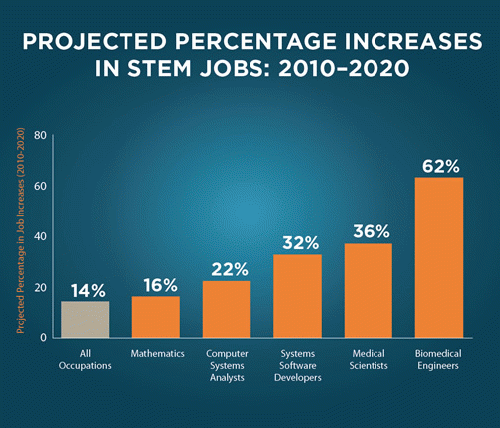by Joe Maness and Richard Kerry Holtzin, Ph.D.
When President John F. Kennedy called upon our nation to take a stroll on the Moon one day, he asked the nation to commit itself on a path of great expectations. One of the most compelling reasons for going to there was to raise the standards of education. After all, if our nation is going to the Moon (so the thinking went), then we're going to need a copious amount of scientists, technologists, engineers, and mathematicians. It was indeed a very well-reasoned argument.
Thus, S.T.E.M. education became a national priority. However, it no longer is. What went wrong? And how do we fix it?
The Bump In the Road
Along the way to the Moon, our space program hit a bump, and we went careening off into a lunar furrow, so to speak. Unfortunately, S.T.E.M. education was severely impaired and never really fully recovered. S.T.E.M. education then became relegated to the more affluent schools that could afford such luxuries as curriculum enrichment. The divide between rich and poor continues unabated today.
To avoid any misunderstanding, it is necessary to emphasize that S.T.E.M. education is still very much alive and thriving in our country. However, it's not alive and thriving for everyone. For example, there are programs and projects that exist that allow students to build and launch small solid-fueled rockets, using special software to track the rocket's progress. Very cool! Very cool, that is, IF the school has a spare couple of thousand dollars to spend on such an adventure. For the less affluent schools, however, this option is not even close to a possibility, because the burden is placed on the teachers. Hence, they must either write a grant, organize a fundraiser, ask for donations, or just go without. Moreover, these extracurricular projects are entirely on their own time!
Indeed, the disparity between affluent and non-affluent schools is striking and embarrassing for our country. But before we can come up with a solution to the problem, we must first understand the problem, and look around at the resources we currently have available to us to find a viable solution.
::
"Let's Work the Problem, People"
This celebrated quote was first uttered by Flight Director Gene Krantz during Apollo 13. That's some darn fine advice there, Gene! In this article's case, the problem can be summed up as such: How can we provide quality S.T.E.M. education at an affordable price? And is there a way to involve space companies in this endeavor? Moreover, is there a way to involve parents and the general community at large as well?
Let's consider the import of the S.T.E.M. acronym and how its designate covers all the proverbial bases. The "S" stands for Science, and that's a fairly easy part of any lesson plan. The same thing can be said for "M" - Mathematics. "T" for Technology, while "E," for Engineering, is not so easy.
The solution to the "T" and "E" components of the S.T.E.M. acronym is both innovative, and uses off-the-shelf products and technology dating back to the 1970s. Students will use software technology to satisfy the "T" portion and build apps using spreadsheets to design a space-mission app. Building the app also requires the student to accomplish the "E" portion as Cloud Software Engineers (Software as a Service). The apps employed in these lessons involve products that current space companies are already operating.
Problem solved!
In view of the abstract just given, here's how this pragmatic concept works: a high school with a computer lab creates a S.T.E.M. laboratory class for 11th and 12th graders. The students learn the basics of computer software: word processing, spreadsheet, slideshow, drawing, forms, and website administration. Email and a calendar will of course be used as well for teacher/student communication and to keep track of project deadlines. For teachers, Professional Development is provided (for free), as well as teacher lesson slideshows and student handouts.
(Note: You can view every article as one long page if you sign up as an Advocate Member, or higher).





